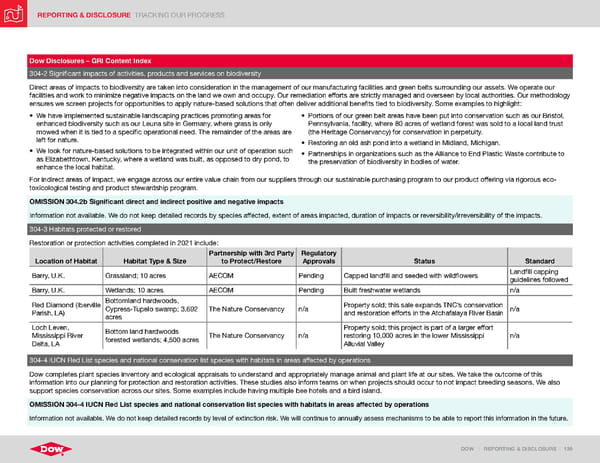REPORTING & DISCLOSURE TRACKING OUR PROGRESS DOW | REPORTING & DISCLOSURE | 139 Dow Disclosures – GRI Content Index 304-2 Significant impacts of activities, products and services on biodiversity Direct areas of impacts to biodiversity are taken into consideration in the management of our manufacturing facilities and green belts surrounding our assets. We operate our facilities and work to minimize negative impacts on the land we own and occupy. Our remediation efforts are strictly managed and overseen by local authorities. Our methodology ensures we screen projects for opportunities to apply nature-based solutions that often deliver additional benefits tied to biodiversity. Some examples to highlight: • We have implemented sustainable landscaping practices promoting areas for enhanced biodiversity such as our Leuna site in Germany, where grass is only mowed when it is tied to a specific operational need. The remainder of the areas are left for nature. • We look for nature-based solutions to be integrated within our unit of operation such as Elizabethtown, Kentucky, where a wetland was built, as opposed to dry pond, to enhance the local habitat. • Portions of our green belt areas have been put into conservation such as our Bristol, Pennsylvania, facility, where 80 acres of wetland forest was sold to a local land trust (the Heritage Conservancy) for conservation in perpetuity. • Restoring an old ash pond into a wetland in Midland, Michigan. • Partnerships in organizations such as the Alliance to End Plastic Waste contribute to the preservation of biodiversity in bodies of water. For indirect areas of impact, we engage across our entire value chain from our suppliers through our sustainable purchasing program to our product offering via rigorous eco- toxicological testing and product stewardship program. OMISSION 304.2b Significant direct and indirect positive and negative impacts Information not available. We do not keep detailed records by species affected, extent of areas impacted, duration of impacts or reversibility/irreversibility of the impacts. 304-3 Habitats protected or restored Restoration or protection activities completed in 2021 include: Location of Habitat Habitat Type & Size Partnership with 3rd Party to Protect/Restore Regulatory Approvals Status Standard Barry, U.K. Grassland; 10 acres AECOM Pending Capped landfill and seeded with wildflowers Landfill capping guidelines followed Barry, U.K. Wetlands; 10 acres AECOM Pending Built freshwater wetlands n/a Red Diamond (Iberville Parish, LA) Bottomland hardwoods, Cypress-Tupelo swamp; 3,692 acres The Nature Conservancy n/a Property sold; this sale expands TNC’s conservation and restoration efforts in the Atchafalaya River Basin n/a Loch Leven, Mississippi River Delta, LA Bottom land hardwoods forested wetlands; 4,500 acres The Nature Conservancy n/a Property sold; this project is part of a larger effort restoring 10,000 acres in the lower Mississippi Alluvial Valley n/a 304-4 IUCN Red List species and national conservation list species with habitats in areas affected by operations Dow completes plant species inventory and ecological appraisals to understand and appropriately manage animal and plant life at our sites. We take the outcome of this information into our planning for protection and restoration activities. These studies also inform teams on when projects should occur to not impact breeding seasons. We also support species conservation across our sites. Some examples include having multiple bee hotels and a bird island. OMISSION 304-4 IUCN Red List species and national conservation list species with habitats in areas affected by operations Information not available. We do not keep detailed records by level of extinction risk. We will continue to annually assess mechanisms to be able to report this information in the future.
 ESG Report | Dow Page 138 Page 140
ESG Report | Dow Page 138 Page 140